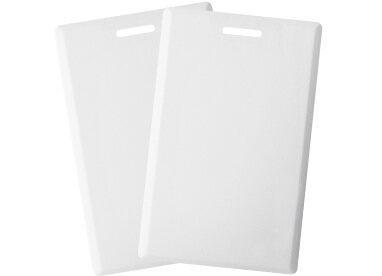Free Needs Analysis
How many IDs will you print per year?
GET LIVE HELP
ID Card Encoding
Add functionality and convenience to your ID card programming with ID card encoding! Store data on your cards using specialty magnetic stripe cards, smart cards, or proximity cards.
ID Card Encoding

ID Card Encoding
Add functionality and convenience to your ID card programming with ID card encoding! Store data on your cards using specialty magnetic stripe cards, smart cards, or proximity cards.
ID Card Encoding
In addition to printing photographs, text, and bar codes, ID card printing systems can encode personalized data onto magnetic stripes, smart cards, and proximity cards for powerful multifunctional cards.
Magnetic Stripe Encoding on ID Cards
Encoding information within magnetic stripes is the oldest and most widely used way to store data on plastic cards. Information - encoded as a series of 1s and 0s - is stored by altering the polarity of microscopic particles embedded within a strip of resin. Magnetizing these particles and printing images onto the rest of the plastic card's blank surface is usually accomplished in the same, single pass of the blank ID card through an ID card printer. Card encoding (and card re-encoding) can also be accomplished by using a separate card encoder. The encoded information is accessed by passing the cards' stripes through specialized readers which detect the magnetized particles' polarities.
Shop Magnetic stripe ID card printers and magnetic stripe blank cards.
Smart Card Encoding on ID Cards
Smart cards refer to any plastic card containing an embedded, integrated circuit microchip or an on-board microprocessor. Data encoded on standard smart cards are accessed by having the smart card directly contact a smart card reader. The reader makes physical contact with a gold plate on the card face and then reads and transmits its data electronically.
Like standard smart cards, contactless smart cards have either electronic microchips or microprocessors. Unlike standard smart cards, they also have embedded antenna that allow the card to communicate with an antenna/coupler unit without making direct physical contact. Smart cards of either sort may be re-encoded - that is, receive and store new information - multiple times by id card printers or separate card encoding devices.
Shop smart cards.
Proximity Card Encoding on ID Cards
Proximity cards store encoded data in embedded electronic circuits. Antennae inside the cards then transmit the translated data as radio waves that can be read by proximity card readers without the need for the card to make physical contact with the reader. They differ from contactless smart cards in that they can not have new information written onto them. For this reason, proximity card encoding is typically done by manufacturers before shipping.
Because users can leave their proximity cards inside their wallets or purses while remote readers process their codes, proximity cards are a convenient and increasingly popular way for institutions and businesses to control access.
Shop prox cards.
Proximity Cards
Compare Prox Brands
 |
 |
|
|---|---|---|
 |
 |
|
| HID Proximity | AlphaPass | |
| Lead Time | 2-3 Weeks | 1-4 Days |
| Frequency | 125 KHz | 125 KHz |
| Format | 26 bit | 26 bit |
| Readers | HID | Universal (including HID, Indala) |
| Clamshell Cards | $2.68 | $2.25 |
| PVC Cards | $4.58 | $3.23 |
| Mag Stripe Cards | $4.98 | $3.56 |
| Fobs | $4.98 | $3.39 |
| Adhesive Tags | $3.28 | $2.79 |
| Vehicle Tags | $27.98 | — |
| Warranty | Lifetime | Lifetime |
| Shop HID | Shop AlphaPass | |
| Save up to 23% over HID |
Not sure how to choose
an ID card printer?








